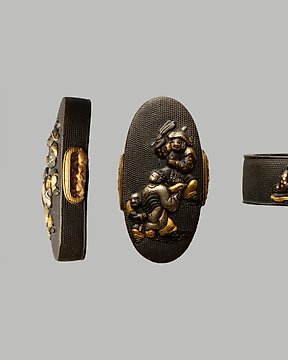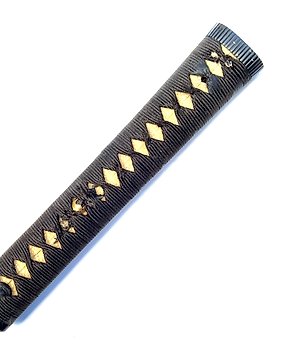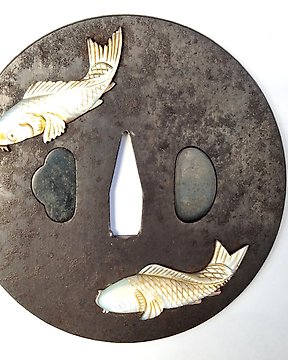Katana - 295K2 Wakizashi Mumei - Japan - Edo-perioden (1600-1868)
Nr. 84001855

Katana - Japan - Midten af Edo-perioden
Nr. 84001855

Katana - Japan - Midten af Edo-perioden
Samurai Sword Tanba No Kami Yoshimichi (Morikichimichi) the fifth generation
Only swordsmiths that were approved by the emperor were given the right to use the chrysanthemum mark on their blades.
Tanba No Kami Morikichimichi (the fifth generation of Kyoto) was called Mishina Toshichiro,
and received Tanba Morikichimichi in the first year of Shotoku year 1711.
The first Tanba no Kami Yoshimichi was the 3rd son of Kanemichi in Mino. He moved to Kyoto in 1559, then received the name as “Tanba no Kami” in 1595.
The kikumon (family crest) has been used by the Japanese emperor families since the Kamakura period. Kiku means chrysanthemum, and is the national flower of Japan. Also, it has been used at shrines relate to the Japanese emperor. This kikumon has 16 petals. According to expert Akira Iwata, the 16 petals of the chrysanthemum originally came from Sumerians who established the oldest civilization in about 3500 BC.
The sword is in superb condition and quite literally takes your breath away. It is abundantly clear why the NBTHK designated this sword a special conservation status, or NBTHK Tokubetsu Hozon.
This sword is not only functional but also considered works of art with great cultural and historical significance.
This Katana belong to high grade Samurai.
Koshirae
Tsuba The paulownia crest and chrysanthemum crest are engraved on the tsuba shaped like a shakudō.
Frame head A paulownia crest is engraved on the shakudo tsuba and colored with gold.
Scabbard Kuro-iro scabbard
Menuki The paulownia crest is engraved and colored with gold (also named as Kiri only for prime minister)
The gentle bamboo blinds give a sense of quality, which is different from Osaka Tanba. Koshirae is also a work of art.
Blade
length 69.6 cm
Sori 1.7 cm
Mekugi 1
Width 3.0 cm
Kisakki 2.1 cm
Hammon Sudare
Weight 680 grams
Era: Edo period, around Shotoku
Signed Kikumon Tanba No Kami Yoshimichi (5th generation) masterpiece Excellent work.
NBTHK Tokubetsu Hozon (A sword especially worthy of conservation)
Du vil måske også kunne lide
- 16+
Denne genstand blev vist i
Sådan køber du hos Catawiki
1. Opdag noget særligt
2. Afgiv det højeste bud
3. Foretag en sikker betaling




